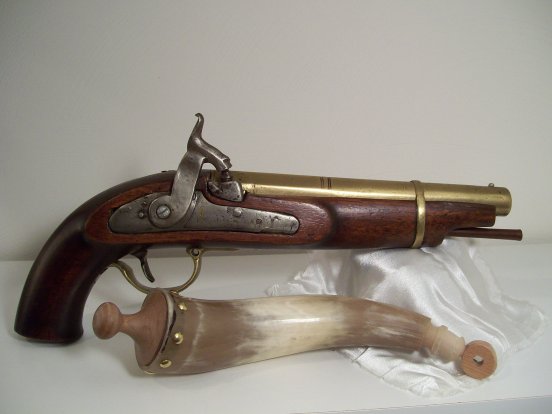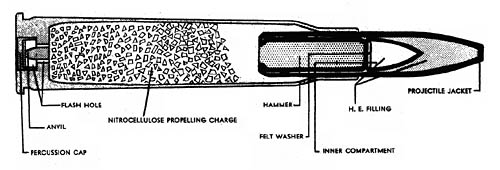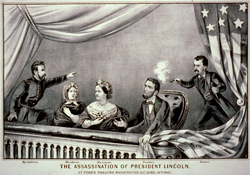With the invention of cartridges the percussion cap is incorporated into the body of the cartridge it self. It is usually at the bottom of the cartridge case. In case of ''centre fire cartridges it is at the centre and in case of 'rim fire' cartridges it is placed in the rim at the bottom.

A muzzle loading pistol and a gun powder casket

How percussion cap works

Percussion cap is incorporated into the cartridge


On April 14, 1865, the assassin John Wilkes Booth shot President Abraham Lincoln during a performance at Ford's Theatre in Washington, DC.
He used a 'muzzle loading single shot pistol' which is called Philadelphia Derringer to kill the president.

It was manufactured by Henry Derringer of Philadelphia. It is about 6 inches long with a 2 1/2 inch barrel. Its weight is only eight ounces. It fired a large ball that was .44 calibre. (The derringer was found on the floor of the State Box at Ford's Theatre. Today it's in the museum and this is the picture of the real gun)
The lead ball was hand made and was 0.44 inch in diameter. This was rather unusual gun and a shot compared to the guns and bullets used today. The hand guns used today are either semiautomatic pistols or revolvers. They are rifled weapons used cartridges containing single bullets. However, semiautomatic pistols can discharge number of bullets without reloading each in to the firing chamber. Since they are semiautomatic, for each fire the trigger has to be pulled as opposed to 'automatic' weapon, in which one pull of trigger can discharge the whole magazine.
The shot killed the president is larger than most of the bullet used in pistols today. For instance 9 mm pistol use cartridges containing bullets of around 9 mm or 0.354 inch in diameter at the base.
Although the Derringer was a muzzle loading the barrel was rifled giving a gyroscopic effect to the lead ball.
The lead ball was hand made and was 0.44 inch in diameter. This was rather unusual gun and a shot compared to the guns and bullets used today. The hand guns used today are either semiautomatic pistols or revolvers. They are rifled weapons used cartridges containing single bullets. However, semiautomatic pistols can discharge number of bullets without reloading each in to the firing chamber. Since they are semiautomatic, for each fire the trigger has to be pulled as opposed to 'automatic' weapon, in which one pull of trigger can discharge the whole magazine.
The shot killed the president is larger than most of the bullet used in pistols today. For instance 9 mm pistol use cartridges containing bullets of around 9 mm or 0.354 inch in diameter at the base.
Although the Derringer was a muzzle loading the barrel was rifled giving a gyroscopic effect to the lead ball.
This is bullet which killed the president. It is deformed perhaps from striking the occipital bone and frontal bone also.
The autopsy report
Dr. J.J. Woodward's autopsy report, April 15, 1865
[A]ided by Assistant Surgeon E. Curtis, U.S.A., I made…this morning an autopsy on the body of President Abraham Lincoln, with the following results:
The eyelids and surrounding parts of the face were greatly ecchymosed and the eyes somewhat protuberant from effusion of blood into the orbits.
There was a gunshot wound of the head around which the scalp was greatly thickened by hemorrhage into its tissue.
The ball entered through the occipital bone about one inch to the left of the median line and just above the left lateral sinus, which it opened. It then penetrated the dura matter, passed through the left posterior lobe of the cerebrum, entered the left lateral ventricle and lodged in the white matter of the cerebrum just above the anterior portion of the left corpus striatum, where it was found.
The wound in the occipital bone was quite smooth, circular in shape, with bevelled edges. The opening through the internal table being larger than that through the external table.
The track of the ball was full of clotted blood and contained several little fragments of bone with small pieces of the ball near its external orifice. The brain around the track was pultaceous and livid from capillary hemorrhage into its substance. The ventricles of the brain were full of clotted blood. A thick clot beneath the dura matter coated the right cerebral lobe.I was said that he was almost shot at 'point blank' range. There were 'powder tatooing' around the wound on the scalp as well.
There was a smaller clot under the dura matter [sic] of the left side. But little blood was found at the base of the brain. Both the orbital plates of the frontal bone were fractured and the fragments pushed upwards toward the brain. The dura matter [sic] over these fractures was uninjured. The orbits were gorged with blood….
Did you notice that autopsy report mentioned about inner bevelling around the entry wound?
Why didn't the shot exit through the frontal bone even if he was shot almost at point blank range?
It was said that the 41 calibre derringer had a muzzle velocity of about 400 feet per second. 9 mm round used today has a muzzle velocity of more than 1000 feet per second. Muzzle velocity of AK-47 rifle is more than 2000 feet per second. Therefore, the shot may not have had enough energy to penetrate the skull twice.
How were the orbital plates fractured?
It was probably due to the increase intra-cranial pressure caused by the unusually large lead shot.
As you probably know that contact range or near contact range shot gun and rifled injuries to the head can cause 'stellate' or 'cruciate' entry wound on the scalp and massive destruction to the skull due to the expanding effect of the gas in side the skull which is called muzzle blast.
Why wasn't there no such destruction in this instance?
It was probably due to the small amount of powder charge producing not enough muzzle blast energy to produce such devastating effects.
Priyanjith Perera
02 December 2012


No comments:
Post a Comment